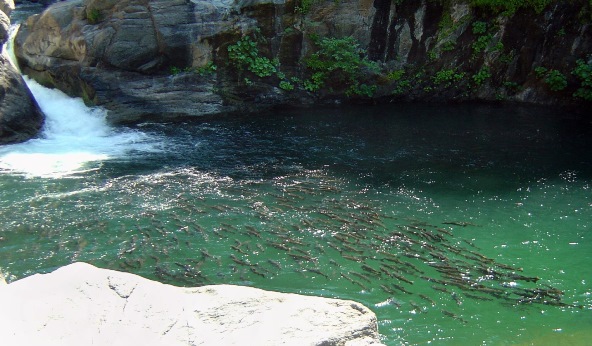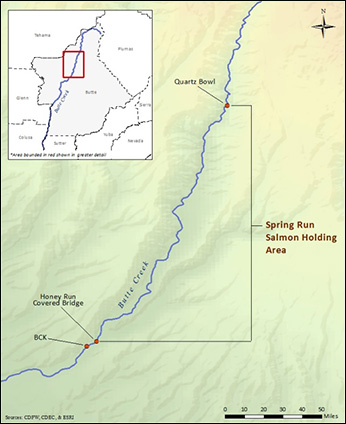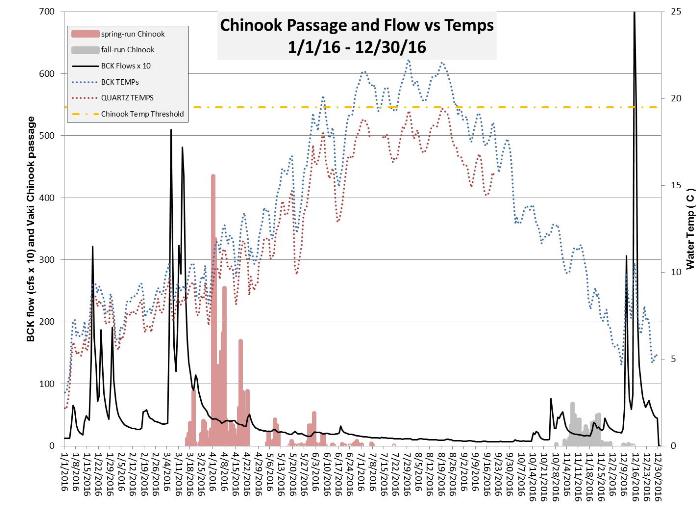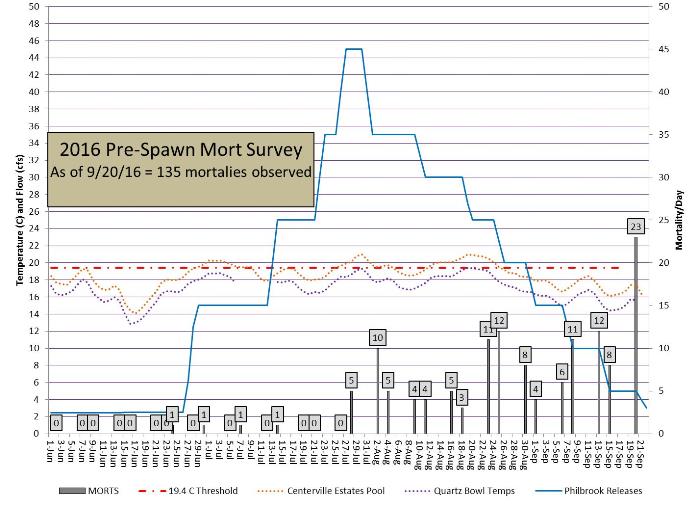Butte Creek, Butte County
2017 Update
Species / Location
 Figure 1. Adult Chinook Salmon holding in a deep pool within the canyon portion of Butte Creek. CDFW photo.
Figure 1. Adult Chinook Salmon holding in a deep pool within the canyon portion of Butte Creek. CDFW photo.
 Figure 2. Map of Butte Creek. Snorkel surveys occurred from Quartz Bowl downstream to Honey Run Bridge on a weekly basis. Temperature loggers were located at Quartz Bowl and the USGS Butte Creek (BCK) gauge. Additionally, flow was recorded at BCK. (click/tap to enlarge)
Figure 2. Map of Butte Creek. Snorkel surveys occurred from Quartz Bowl downstream to Honey Run Bridge on a weekly basis. Temperature loggers were located at Quartz Bowl and the USGS Butte Creek (BCK) gauge. Additionally, flow was recorded at BCK. (click/tap to enlarge)
Spring-run Chinook Salmon (Oncorhynchus tshawytscha) has been listed as “threatened” under both the California Endangered Species Act and federal Endangered Species Act since 1999. Butte Creek harbors one of three self-sustaining populations in the Central Valley (Figures 1 and 2).
Need for Drought Stressor Monitoring
In 2016, California experienced its fifth consecutive extremely dry year, constituting one of the worst droughts in the state’s recorded history. Historically, spring-run Chinook Salmon populations were found in most of the eastern tributaries of the Sacramento and San Joaquin rivers. Unfortunately, large dams and water development projects eliminated access to all but a few remaining self-sustaining tributaries (CDFG 1998). Butte Creek is one of only three Central Valley streams that continue to harbor a self-sustaining population of spring-run Chinook Salmon. The other two are nearby Deer and Mill creeks. As anadromous fish, spring-run Chinook Salmon hatch in freshwater, migrate to the ocean to mature, and return to their birth stream to spawn as adults. Uniquely, adult spring-run Chinook Salmon enter freshwater in the late winter and spring, spending up to eight months holding in streams prior to spawning. This extended fresh water residency requires that adults have access to suitable holding habitat—deep, cool, highly oxygenated pools—to survive high summer temperatures in the Central Valley.
Stressor Monitoring Efforts
CDFW collaborated with the "Operations Team," which consisted of representatives from CDFW, California State Water Resources Control Board, National Marine Fisheries Service, U.S. Fish and Wildlife Service, and PG&E to proactively manage water delivery and its timing from the West Branch of the Feather River, a nearby tributary to the Sacramento River, into Butte Creek. The cooperation of these agencies played an important role in helping the spring-run Chinook Salmon cope with low flows and high water temperatures stemming from the current drought conditions. Generally, elevated creek temperatures during the hot summer holding period can result in an increase of spring-run Chinook Salmon mortalities. However, mortalities can be reduced when the Operations Team implements water release strategies to help mitigate “heat storms” thereby reducing water temperatures in Butte Creek. In addition to the interagency efforts, CDFW personnel also conducted weekly snorkel surveys of the entire holding habitat, a 17.7 km reach of stream (Figure 2). Survey crews documented the number of spring-run Chinook Salmon that died-off prior to spawning (pre-spawn mortalities), determined fish distribution within the creek, and documented any change in holding patterns over the summer period.
Findings
Water Temperature Monitoring
CDFW monitored water temperature at eight different sites. Drought funding enabled crews to deploy an additional five water temperature loggers in key stream reaches. Thermographs were used to track stream conditions and any changes in temperature based on the flow releases made from upstream PG&E project reservoirs. Water temperature plays an important role in fish distribution within the holding habitat. As water temperatures increase during the summer months, spring-run Chinook Salmon tend to migrate further upstream seeking cooler refugia.
Vaki Riverwatcher
 Figure 3. Adult spring-run Chinook Salmon through Vaki Riverwatcher. CDFW photo.
Figure 3. Adult spring-run Chinook Salmon through Vaki Riverwatcher. CDFW photo.
The Vaki Riverwatcher is used to monitor fish migration patterns by providing infrared scanning images and high resolution video of fish species that pass through the Durham Mutual fish ladder (Figure 3). The Vaki Riverwatcher is operated year round and documents the arrival of spring-run Chinook Salmon into Butte Creek.
The Vaki Riverwatcher can be used to temporally and spatially delineate the different runs of Chinook Salmon on Butte Creek. Video obtained during February through June show spring-run Chinook Salmon arrival into Butte Creek when flows are relatively high and water temperatures are low. As flow decreases and water temperatures increase, spring-run Chinook Salmon immigration slows and ceases during the hotter summer months. Video obtained during October through December show a typical fall-run Chinook Salmon timing pattern of immigrating when stream flows are increasing and water is cooler (Figure 4).
 Figure 4. Adult Chinook Salmon upstream migration through Vaki Riverwatcher. *preliminary data subject to revision. (click/tap to enlarge)
Figure 4. Adult Chinook Salmon upstream migration through Vaki Riverwatcher. *preliminary data subject to revision. (click/tap to enlarge)
Pre-spawn Mortality Survey
The annual pre-spawn mortality survey is typically funded by PG&E as part of the DeSabla-Centerville Hydroelectric Project. However, drought funding allowed for surveys to begin earlier in the year and to cover broader reaches of the stream. Due to low stream flow, crews began surveying in early spring and recorded spring-run distribution patterns, reporting any potential delays in migration and documenting any pre-spawn mortalities. During the 2016 pre-spawn survey period, which occurred from June 1 through September 20, 135 carcasses were encountered with an expanded pre-spawn mortality total of 360 (Figure 5).
 Figure 5. Temperature and number of spring-run Chinook Salmon that died per day before spawning in Butte Creek, June 1 - September 17, 2016. *preliminary data subject to revision. (click/tap to enlarge)
Figure 5. Temperature and number of spring-run Chinook Salmon that died per day before spawning in Butte Creek, June 1 - September 17, 2016. *preliminary data subject to revision. (click/tap to enlarge)
Carcass Survey
Following pre-spawn mortality surveys are carcass surveys. These surveys begin at the initiation of spawning, beginning in mid-September, to estimate the number of spring-run that survived over the summer to spawn. The 2016 carcass survey indicated that 4,450 spring-run Chinook Salmon successfully spawned in Butte Creek, a marked increase from 2015, when surveys indicated that only 413 spring-run Chinook Salmon had spawned successfully. Collaboration coupled with real time adaptive management strategies of water releases contributed to the annual success of spring-run Chinook Salmon surviving the long, hot summer drought conditions and into the spawning season.
Future Efforts
While ongoing real-time monitoring of Butte Creek’s spring-run Chinook Salmon continues each year to document environmental factors, fish distribution, pre-spawn mortalities, and behavioral patterns, the funding provided as part of the state's comprehensive drought response increased and enhanced monitoring efforts. This helped inform targeted drought response actions. Continued coordination and collaboration will play a vital role in ensuring that the returning future populations of Butte Creek spring-run Chinook Salmon will have the best chance at surviving and contributing to the overall resources of California.
References
- California Department of Fish and Game (CDFG). 1998. A Status Review of the Spring-run Chinook Salmon (Oncorhynchus tshawytscha) in the Sacramento River Drainage. Prepared by the California Department of Fish and Game.
CDFW
Pacific States Marine Fisheries Commission
National Marine Fisheries Service
State Water Regional Water Quality Control Board
Pacific Gas and Electric Company